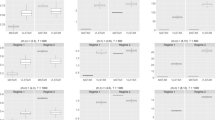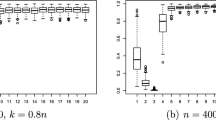Abstract
We propose a vector auto-regressive model with a low-rank constraint on the transition matrix. This model is well suited to predict high-dimensional series that are highly correlated, or that are driven by a small number of hidden factors. While our model has formal similarities with factor models, its structure is more a way to reduce the dimension in order to improve the predictions, rather than a way to define interpretable factors. We provide an estimator for the transition matrix in a very general setting and study its performances in terms of prediction and adaptation to the unknown rank. Our method obtains good result on simulated data, in particular when the rank of the underlying process is small. On macroeconomic data from Giannone et al. (Rev Econ Stat 97(2):436–451, 2015), our method is competitive with state-of-the-art methods in small dimension and even improves on them in high dimension.



Similar content being viewed by others
References
Alquier, P., Guedj, B.: Simpler PAC-Bayesian bounds for hostile data. Mach. Learn. 107(5), 887–902 (2018)
Alquier, P., Li, X.: Prediction of quantiles by statistical learning and application to GDP forecasting. In: International Conference on Discovery Science, pp. 22–36. Springer, Berlin (2012)
Alquier, P., Marie, N.: Matrix factorization for multivariate time series analysis. Electron. J. Stat. 13(2), 4346–4366 (2019)
Alquier, P., Wintenberger, O.: Model selection for weakly dependent time series forecasting. Bernoulli 18(3), 883–913 (2012)
Alquier, P., Li, X., Wintenberger, O.: Prediction of time series by statistical learning: general losses and fast rates. Depend. Model. 1, 65–93 (2013)
Alquier, P., Cottet, V., Lecué, G.: Estimation bounds and sharp oracle inequalities of regularized procedures with Lipschitz loss functions. Ann. Stat. 47(4), 2117–2144 (2019a)
Alquier, P., Doukhan, P., Fan, X.: Exponential inequalities for nonstationary Markov chains. Depend. Model. 7, 150–168 (2019b)
Anderson, T.W.: Estimating linear restrictions on regression coefficients for multivariate normal distributions. Ann. Math. Stat. 22(3), 327–351 (1951)
Arlot, S.: Minimal penalties and the slope heuristics: a survey. arXiv preprint arXiv:1901.07277 (2019)
Arlot, S., Massart, P.: Data-driven calibration of penalties for least-squares regression. J. Mach. Learn. Res. 10(Feb), 245–279 (2009)
Basu, S., Meckesheimer, M.: Automatic outlier detection for time series: an application to sensor data. Knowl. Inf. Syst. 11(2), 137–154 (2007)
Basu, S., Li, X., Michailidis, G.: Low rank and structured modeling of high-dimensional vector autoregressions. IEEE Trans. Signal Process. 67(5), 1207–1222 (2019)
Baudry, J.-P., Maugis, C., Michel, B.: Slope heuristics: overview and implementation. Stat. Comput. 22(2), 455–470 (2012)
Bauwens, L., Laurent, S., Rombouts, J.V.K.: Multivariate GARCH models: a survey. J. Appl. Econom. 21, 79–109 (2006)
Bing, X., Wegkamp, M.H.: Adaptive estimation of the rank of the coefficient matrix in high-dimensional multivariate response regression models. Ann. Stat. 47(6), 3157–3184 (2019)
Birgé, L., Massart, P.: Minimal penalties for Gaussian model selection. Probab. Theory Relat. Fields 138(1–2), 33–73 (2007)
Boyd, S., Parikh, N., Chu, E., Peleato, B., Eckstein, J., et al.: Distributed optimization and statistical learning via the alternating direction method of multipliers. Found. Trends® Mach. Learn. 3(1), 1–122 (2011)
Buja, A., Hastie, T., Tibshirani, R.: Linear smoothers and additive models. Ann. Stat. 17(2), 453–510 (1989)
Bunea, F., She, Y., Wegkamp, M.H.: Optimal selection of reduced rank estimators of high-dimensional matrices. Ann. Stat. 39(2), 1282–1309 (2011)
Candès, E.J., Plan, Y.: Tight oracle inequalities for low-rank matrix recovery from a minimal number of noisy random measurements. IEEE Trans. Inf. Theory 57(4), 2342–2359 (2011)
Carel, L.: Big data analysis in the field of transportation. Ph.D. thesis, Université Paris-Saclay (2019)
Cesa-Bianchi, N., Lugosi, G.: Prediction, Learning, and Games. Cambridge University Press, Cambridge (2006)
Chan, J., Leon-Gonzalez, R., Strachan, R.W.: Invariant inference and efficient computation in the static factor model. J. Am. Stat. Assoc. 113(522), 819–828 (2018)
Chen, L., Wu, W.B.: Testing for trends in high-dimensional time series. J. Am. Stat. Assoc. 114, 869–881 (2018)
Cornec, M.: Constructing a conditional GDP fan chart with an application to French business survey data. OECD J. J. Bus. Cycle Meas. Anal. 2013(2), 109–127 (2014)
Davis, R.A., Zang, P., Zheng, T.: Sparse vector autoregressive modeling. J. Comput. Graph. Stat. 25(4), 1077–1096 (2016)
De Castro, Y., Goude, Y., Hébrail, G., Mei, J.: Recovering multiple nonnegative time series from a few temporal aggregates. In: ICML 2017-34th International Conference on Machine Learning, pp. 1–9 (2017)
Dedecker, J., Doukhan, P., Lang, G., León, JR., Louhichi, S., Prieur, C.: Weak Dependence: With Examples and Applications. Lecture Notes in Statistics, vol. 190, p. xiv+318. Springer, New York (2007)
Dedecker, J., Fan, X.: Deviation inequalities for separately Lipschitz functionals of iterated random functions. Stoch. Process. Appl. 125(1), 60–90 (2015)
Dedecker, J., Doukhan, P., Fan, X.: Deviation inequalities for separately Lipschitz functionals of composition of random functions. J. Math. Anal. Appl. 479(2), 1549–1568 (2019)
Doukhan, P.: Stochastic Models for Time Series. Series Mathématiques et Applications, vol. 80. Springer, Berlin (2018)
Engle, R.: ARCH: Selected Readings. Oxford University Press, Oxford (1995)
Francq, C., Zakoian, J.-M.: GARCH Models: Structure, Statistical Inference and Financial Applications. Wiley, New York (2019)
Gaillard, P., Goude, Y., Nedellec, R.: Additive models and robust aggregation for GEFCom2014 probabilistic electric load and electricity price forecasting. Int. J. Forecast. 32(3), 1038–1050 (2016)
Garnier, R.: Simulations for penalized estimation of VAR with law rank. https://github.com/garnier94/Simulation_low_rank_VAR1 (2019)
Ge, R., Jin, C., Zheng, Y.: No spurious local minima in nonconvex low rank problems: a unified geometric analysis. In: Proceedings of the 34th International Conference on Machine Learning, vol. 70, pp. 1233–1242. JMLR. org (2017)
Giannone, D., Lenza, M., Primiceri, G.E.: Prior selection for vector autoregressions. Rev. Econ. Stat. 97(2), 436–451 (2015)
Giordani, P., Pitt, M., Kohn, R.: Bayesian inference for time series state space models. In: Geweke, J., Koop, G., Van Dijk, H. (eds.) The Oxford Handbook of Bayesian Econometrics. Oxford University Press, Oxford (2011)
Giraud, C., Roueff, F., Sanchez-Perez, A.: Aggregation of predictors for nonstationary sub-linear processes and online adaptive forecasting of time varying autoregressive processes. Ann. Stat. 43(6), 2412–2450 (2015)
Hallin, M., Lippi, M.: Factor models in high-dimensional time series—a time-domain approach. Stoch. Process. Appl. 123(7), 2678–2695 (2013)
Hang, H., Steinwart, I.: Fast learning from \(\alpha \)-mixing observations. J. Multivar. Anal. 127, 184–199 (2014)
Izenman, A.J.: Reduced-rank regression for the multivariate linear model. J. Multivar. Anal. 5(2), 248–264 (1975)
Ji, S., Ye, J.: An accelerated gradient method for trace norm minimization. In: Proceedings of the 26th Annual International Conference on Machine Learning, pp. 457–464. ACM (2009)
Jochmann, M., Koop, G., Leon-Gonzalez, R., Strachan, R.W.: Stochastic search variable selection in vector error correction models with an application to a model of the UK macroeconomy. J. Appl. Econom. 28(1), 62–81 (2013)
Klopp, O., Lounici, K., Tsybakov, A.B.: Robust matrix completion. Probab. Theory Relat. Fields 169(1–2), 523–564 (2017)
Klopp, O., Lu, Y., Tsybakov, A.B., Zhou, H.H.: Structured matrix estimation and completion. Bernoulli 25(4B), 3883–3911 (2019)
Koltchinskii, V., Lounici, K., Tsybakov, A.B.: Nuclear-norm penalization and optimal rates for noisy low-rank matrix completion. Ann. Stat. 39(5), 2302–2329 (2011)
Koop, G., Potter, S.: Forecasting in dynamic factor models using Bayesian model averaging. Econom. J. 7(2), 550–565 (2004)
Kumar, M., Patel, N.R.: Using clustering to improve sales forecasts in retail merchandising. Ann. Oper. Res. 174(1), 33–46 (2010)
Kuznetsov, V., Mohri, M.: Learning theory and algorithms for forecasting non-stationary time series. In: Advances in Neural Information Processing Systems, pp. 541–549 (2015)
Lam, C., Yao, Q.: Factor modeling for high-dimensional time series: inference for the number of factors. Ann. Stat. 40(2), 694–726 (2012)
Lam, C., Yao, Q., Bathia, N.: Estimation of latent factors for high-dimensional time series. Biometrika 98(4), 901–918 (2011)
Lippi, M., Bertini, M., Frasconi, P.: Short-term traffic flow forecasting: an experimental comparison of time-series analysis and supervised learning. IEEE Trans. Intell. Transp. Syst. 14(2), 871–882 (2013)
Lipton, Z.C., Kale, D.C., Wetzel, R.: Modeling missing data in clinical time series with RNNs. In: Machine Learning for Healthcare, vol. 56 (2016)
London, B., Huang, B., Taskar, B., Getoor, L.: PAC-Bayesian collective stability. In: Artificial Intelligence and Statistics, pp. 585–594 (2014)
McDonald, D.J., Shalizi, C.R., Schervish, M.: Nonparametric risk bounds for time-series forecasting. J. Mach. Learn. Res. 18(32), 1–40 (2017)
Meir, R.: Nonparametric time series prediction through adaptive model selection. Mach. Learn. 39(1), 5–34 (2000)
Moridomi, K., Hatano, K., Takimoto, E.: Tighter generalization bounds for matrix completion via factorization into constrained matrices. IEICE Trans. Inf. Syst. 101(8), 1997–2004 (2018)
Negahban, S., Wainwright, M.J.: Estimation of (near) low-rank matrices with noise and high-dimensional scaling. Ann. Stat. 39(2), 1069–1097 (2011)
Poignard, B.: Sparse multivariate ARCH models: finite sample properties. https://arxiv.org/pdf/1808.05352v1.pdf (2018)
Purser, A., Bergmann, M., Lundälv, T., Ontrup, J., Nattkemper, T.W.: Use of machine-learning algorithms for the automated detection of cold-water coral habitats: a pilot study. Mar. Ecol. Prog. Ser. 397, 241–251 (2009)
Saha, A., Sindhwani, V.: Learning evolving and emerging topics in social media: a dynamic NMF approach with temporal regularization. In: Proceedings of the Fifth ACM International Conference on Web Search and Data Mining, pp. 693–702. ACM (2012)
Shalizi, C., Kontorovich, A.: Predictive PAC learning and process decompositions. In: Advances in Neural Information Processing Systems, pp. 1619–1627 (2013)
Steinwart, I., Christmann, A.: Fast learning from non-iid observations. In: Advances in Neural Information Processing Systems, pp. 1768–1776 (2009)
Steinwart, I., Hush, D., Scovel, C.: Learning from dependent observations. J. Multivar. Anal. 100(1), 175–194 (2009)
Suzuki, T.: Convergence rate of Bayesian tensor estimator and its minimax optimality. In: International Conference on Machine Learning, pp. 1273–1282 (2015)
Vapnik, V.: Statistical Learning Theory. Wiley, New York (1998)
Author information
Authors and Affiliations
Corresponding author
Additional information
Publisher's Note
Springer Nature remains neutral with regard to jurisdictional claims in published maps and institutional affiliations.
P. Alquier: This author gratefully acknowledges financial support from the research programme New Challenges for New Data from LCL and GENES, hosted by the Fondation du Risque and from Labex ECODEC (ANR-11-LABEX-0047). P. Doukhan: The work of the second and the third authors has been developed within the MME-DII center of excellence (ANR-11-LABEX-0023-01) and with the help of PAI-CONICYT MEC \(\hbox {N}^\circ \) 80170072. The authors have been supported by Fondecyt Project 1171335 and Mathamsud 18-MATH-07.
Rights and permissions
About this article
Cite this article
Alquier, P., Bertin, K., Doukhan, P. et al. High-dimensional VAR with low-rank transition. Stat Comput 30, 1139–1153 (2020). https://doi.org/10.1007/s11222-020-09929-7
Received:
Accepted:
Published:
Issue Date:
DOI: https://doi.org/10.1007/s11222-020-09929-7




